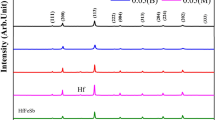Ultrahigh-temperature ZrB2-based ceramics with different sintering additions was developed for extreme conditions. Its strength characteristics, phase composition, and structure were examined. The ceramics was oxidized in air at 1250 and 1550°C. In addition, the most stable composites were subjected to temperature cycling in a flow of aviation fuel combustion products in a temperature range of 1400–1500°C. All materials show high oxidation resistance. The method used to produce samples influences their oxidation behavior: materials produced by vacuum hot pressing show higher oxidation resistance than those produced by hot pressing in a CO–CO2 atmosphere, probably because of their higher final density. The best results were obtained when ZrB2 sintering was combined with introduction of MoSi2 and CrB2.









Similar content being viewed by others
References
Shu-Qi Guo, “Densification of ZrB2-based composites and their mechanical and physical properties: A review,” J. Eur. Ceram. Soc., 29, 995–1011 (2009).
F. Monteverde and A. Bellosi, “Oxidation of ZrB2-based ceramics in dry air,” J. Electrochem. Soc., 150, 552–559 (2003).
Hu Ping, Zhang Xing-Hong, and Han Jie-Cai, “Effect of various additives on the oxidation behavior of ZrB2-based ultrahigh-temperature ceramics at 1800°C,” J. Am. Ceram. Soc., 93, Issue 2, 345–349 (2010).
O. N. Grigoriev, B. A. Galanov, V. A. Lavrenko, et al., “Oxidation of ZrB2–SiC–ZrSi2 ceramics in oxygen,” J. Eur. Ceram. Soc., 30, 2397–2405 (2010).
J. F. Justin and A. Jankowiak, “Ultrahigh-temperature ceramics: densification, properties and thermal stability,” J. Aerosp. Lab., 3, 1–10 (2011).
D. Sciti, R. Savino, and L. Silvestroni, “Aerothermal behavior of a SiC fiber-reinforced ZrB2 sharp component in supersonic regime,” J. Eur. Ceram. Soc., 32, 1837–1845 (2012).
V. O. Lavrenko, A. D. Panasyuk, O. M. Grigoriev, et al., “High-temperature (to 1600°C) oxidation of ZrB2–MoSi2 ceramics in air,” Powder Metall. Met. Ceram., 51, No. 1–2, 102–107 (2012).
O. N. Grigoriev, G. A. Frolov, U. I. Evdokimenko, et al., “Ultrahigh temperature ceramics behavior under the impact of concentrated solar radiation, oxidation and erosion in gas flows,” in: Space Investigations in Ukraine 2014, Akademperiodyka, Kyiv (2014), pp. 126–132.
T. V. Mosina, I. P. Neshpor, O. M. Grigoriev, et al., “Corrosion resistance of ultrahigh-temperature zirconium boride ceramics under concentrated solar radiation,” Powder Metall. Met. Ceram., 54, No. 3–4, 189–193 (2015).
A. Kaiser, M. Lobert, and R. Telle, “Thermal stability of zircon (ZrSiO4),” J. Eur. Ceram. Soc., 28, 2199–2211 (2008).
Author information
Authors and Affiliations
Corresponding author
Additional information
Translated from Poroshkovaya Metallurgiya, Vol. 56, Nos. 9–10 (517), pp. 110–119, 2017.
Rights and permissions
About this article
Cite this article
Grigoriev, O.N., Neshpor, I.P., Mosina, T.V. et al. Behavior of Ultrahigh-Temperature ZrB2-Based Ceramics in Oxidation. Powder Metall Met Ceram 56, 573–580 (2018). https://doi.org/10.1007/s11106-018-9930-z
Received:
Published:
Issue Date:
DOI: https://doi.org/10.1007/s11106-018-9930-z



